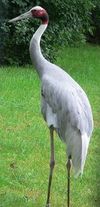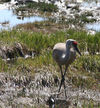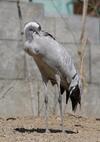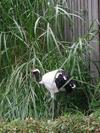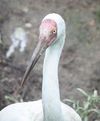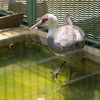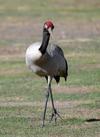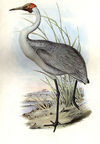Genus Grus
Whooping crane - Adult whooping cranes are white with a red crown and a long, dark, pointed bill. Immature whooping cranes are pale brown. While in flight, their long necks are kept straight and their long dark legs trail behind. Adult whooping cranes' black wing tips are visible during flight.
Sarus Crane - The Sarus Crane is a large non-migratory crane found in parts of the Indian Subcontinent, Southeast Asia and Australia. The tallest of the flying birds, standing at a height of up to 1.8 m , species of open wetlands. The Sarus Crane is easily distinguished from other cranes in the region by the overall grey colour and the contrasting red head and upper neck. They forage on marshes and shallow wetlands for roots, tubers, insects, crustaceans and small vertebrate prey. Like other cranes, they form long-lasting pair-bonds and maintain territories within which they perform territorial and courtship displays that include loud trumpeting, leaps and dance-like movements. In India they are considered symbols of marital fidelity, believed to mate for life and pine the loss of their mates even to the point of starving to death. The main breeding season is during the rainy season, when the pair builds an enormous nest "island", a circular platform of reeds and grasses nearly two metres in diameter and high enough t
Sandhill Crane - Ardea canadensis Linnaeus, 1758 Grus minor Grus proavus and see text
Wattled Crane - At a height of up to 175 cm , it is the largest crane in Africa and is the second tallest species of crane, after the Sarus Crane. The wingspan is 230-260 cm , the length is typically 120 cm and weight is 6.4-7.9 kg in females, 7.5-9 kg in males. The back and wings are ashy gray. The feathered portion of the head is dark slaty gray above the eyes and on the crown, but is otherwise white, including the wattles, which are almost fully feathered and hang down from under the upper throat. The breast, primaries, secondaries, and tail coverts are black. The secondaries are long and nearly reach the ground. The upper breast and neck are white all the way to the face. The skin in front of the eye extending to the base of the beak and tip of the wattles is red and bare of feathers and covered by small round wart-like bumps. Wattled Cranes have long bills and black legs and toes. Males and females are virtually indistinguishable, although males tend to be slightly larger.
Common crane - The Common Crane , also known as the Eurasian Crane, is a bird of the family Gruidae, the cranes.
Japanese crane - The Red-crowned Crane , also called the Japanese Crane or Manchurian Crane, is a large crane and is the second rarest crane in the world .
Great White Crane - This species breeds in arctic Russia in Yakutia and western Siberia. It is a long distance migrant. The eastern population winters on the Yangtze River and Lake Poyang in China, the central population at Keoladeo National Park, India , and the western population in Fereydoon Kenar in Iran. It breeds and winters in wetlands, where it feeds on the shoots, roots and tubers of aquatic plants.
Hooded crane - The Hooded Crane breeds in south-central and south-eastern Siberia. Breeding is also suspected in Mongolia. Over 80% of its population winters at Izumi, southern Japan. There are also wintering grounds in South Korea and China.
Black-necked crane - The Black-necked Crane is distributed in Pakistan, China, Himalayan regions of the Republic of India, Bhutan and Vietnam. It breeds on the Tibetan Plateau, with a small population in adjacent Ladakh, and Kashmir valleys. It has therefore been designated as the "State bird of Jammu and Kashmir". It has six wintering areas, mostly at lower altitudes in China, notably at Caohai Lake, but it also winters in Bhutan. In Jammu and Kashmir, the crane breeds near the high altitude lakes of Ladakh such as Tso Kar Lake. The Black-necked Crane is one of the spiritual creatures for the people of the area and is pictured alongside many of their deities in the monasteries of the region.
Grus paradisea - Blue Cranes are birds of the dry, grassy uplands which feed on seeds and insects and spend little time in wetlands. They are altitudinal migrants, generally nesting in the upper grasslands and moving down to lower altitudes for winter. Many occupy agricultural areas.
Brolga - The Brolga is a common gregarious wetland bird species in tropical and eastern Australia, well known for its intricate mating dance. It is the official bird emblem of the state of Queensland.
Japanese White-naped Crane - The White-naped Crane breeds in northeastern Mongolia, northeastern China, and adjacent areas of southeastern Russia where a program at Khinganski Nature Reserve raises eggs provided from US.
Grus virgo - The Demoiselle is 85–100 cm long with a 155–180 cm wingspan, slightly smaller than the Common Crane but with similar plumage. It has a long white neck stripe and the black on the foreneck extends down over the chest in a plume.


